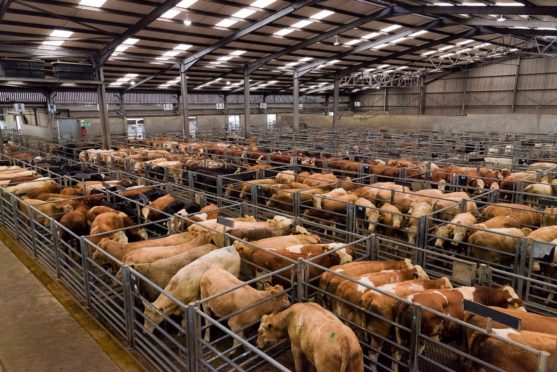Scottish farmers and crofters are receiving some of the highest prices paid in more than 20 years for their cattle, according to figures from Quality Meat Scotland (QMS).
Data from the red meat levy body reveals farmgate prime cattle prices continue to be at the highest level for more than 20 years, with current prices trading around 25% higher than this time last year.
Prime cattle sold at ANM Group’s Thainstone Mart, near Inverurie, on Thursday averaged 233.2p per kg for bullocks and 236.9p per kg for heifers. This compares to average prices of 186.3p for bullocks and 192.3p for heifers at their sale on May 7, 2020.
Prices were also up on the year at Dingwall and Highland Marts’ Dingwall Mart on Tuesday where prime bullocks averaged 239.7p per kg and prime heifers averaged 244p per kg. This compares to average prices of 203.9p and 206.6p per kg for bullocks and heifers respectively.
It was a similar picture at Lawrie & Symington Ltd’s Forfar Mart on Wednesday when prime bullocks averaged 257p and prime heifers averaged 260p per kg – up from averages of 209p for bullocks and 230p for heifers at the company’s sale on May 6, 2020.
QMS director of economics services, Stuart Ashworth, said after an initial dip, prices have climbed steeply since the introduction of Covid-19 control measures more than a year ago.
“Prices are also firmer across Europe with Irish prices 18% higher when quoted in Euro – 17% when quoted in Sterling – than a year ago and the average steer price across the EU being 16% higher,” added Mr Ashworth.
“This does mean, though, that the UK premium over Irish prices has widened considerably from around 12% a year ago to the unusually high level of 18%.”
He said Covid-19 restrictions had completely changed the way consumers bought and used meat and estimates from consumer research body Kantar Worldpanel suggest retails sales of fresh beef in the 12 months following the start of lockdown measures had increased by almost 10%.
“Clearly, sales in other outlets dropped as consumers had to take more responsibility for preparing their own meals,” added Mr Ashworth.
“As consumers became more confident in their meal preparation skills, they also changed the balance of cuts they bought – for example buying less mince and more roasting joints and steak – and equally there was greater interest in ready to cook dishes and marinaded products.”
Mr Ashworth said a reduction in the number of cattle reaching UK abattoirs was also a factor in the recent price rises.
“BCMS data indicates a continued tightness of prime cattle supplies – a situation that is unlikely to materially change until the autumn, which will continue to underpin domestic farmgate prices as the supply chain adjusts to the relaxation of Covid-19 restrictions,” he added.

